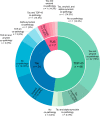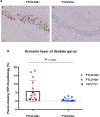Psychiatric symptoms of frontotemporal dementia and subcortical (co-)pathology burden: new insights
- PMID: 35136978
- PMCID: PMC9825544
- DOI: 10.1093/brain/awac043
Psychiatric symptoms of frontotemporal dementia and subcortical (co-)pathology burden: new insights
Abstract
Three subtypes of distinct pathological proteins accumulate throughout multiple brain regions and shape the heterogeneous clinical presentation of frontotemporal lobar degeneration (FTLD). Besides the main pathological subtypes, co-occurring pathologies are common in FTLD brain donors. The objective of this study was to investigate how the location and burden of (co-)pathology correlate to early psychiatric and behavioural symptoms of FTLD. Eighty-seven brain donors from The Netherlands Brain Bank cohort (2008-2017) diagnosed with FTLD were included: 46 FTLD-TAR DNA-binding protein 43 (FTLD-TDP), 34 FTLD-tau, and seven FTLD-fused-in-sarcoma (FTLD-FUS). Post-mortem brain tissue was dissected into 20 standard regions and stained for phosphorylated TDP-43, phosphorylated tau, FUS, amyloid-β, and α-synuclein. The burden of each pathological protein in each brain region was assessed with a semi-quantitative score. Clinical records were reviewed for early psychiatric and behavioural symptoms. Whole-brain clinico-pathological partial correlations were calculated (local false discovery rate threshold = 0.01). Elaborating on the results, we validated one finding using a quantitative assessment of TDP-43 pathology in the granular layer of the hippocampus in FTLD-TDP brain donors with (n = 15) and without (n = 15) hallucinations. In subcortical regions, the presence of psychiatric symptoms showed positive correlations with increased hippocampal pathology burden: hallucinations with TDP-43 in the granular layer (R = 0.33), mania with TDP-43 in CA1 (R = 0.35), depression with TDP-43 in CA3 and with parahippocampal tau (R = 0.30 and R = 0.23), and delusions with CA3 tau (R = 0.26) and subicular amyloid-β (R = 0.25). Behavioural disinhibition showed positive correlations with tau burden in the thalamus (R = 0.29) and with both TDP-43 and amyloid-β burden in the subthalamus (R = 0.23 and R = 0.24). In the brainstem, the presence of α-synuclein co-pathology in the substantia nigra correlated with disinhibition (R = 0.24), tau pathology in the substantia nigra correlated with depression (R = 0.25) and in the locus coeruleus with both depression and perseverative/compulsive behaviour (R = 0.26 and R = 0.32). The quantitative assessment of TDP-43 in the granular layer validated the higher burden of TDP-43 pathology in brain donors with hallucinations compared to those without hallucinations (P = 0.007). Our results show that psychiatric symptoms of FTLD are linked to subcortical pathology burden in the hippocampus, and hallucinations are linked to a higher burden of TDP-43 in the granular layer. Co-occurring non-FTLD pathologies in subcortical regions could contribute to configuring the clinical phenotype of FTLD.
Keywords: copathology; frontotemporal dementia; hallucinations; psychiatric symptoms; subcortical.
© The Author(s) 2022. Published by Oxford University Press on behalf of the Guarantors of Brain.
Figures



References
Publication types
MeSH terms
Substances
Grants and funding
LinkOut - more resources
Full Text Sources
Miscellaneous

